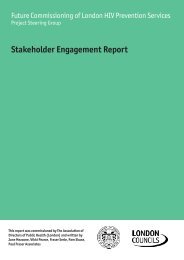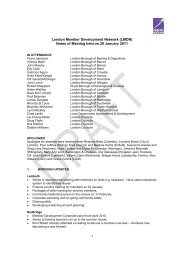Stakeholder Engagement Report - London Councils
Stakeholder Engagement Report - London Councils
Stakeholder Engagement Report - London Councils
Create successful ePaper yourself
Turn your PDF publications into a flip-book with our unique Google optimized e-Paper software.
“I have seen massive changes in people. I know that money is tight and that there<br />
is lots of noise around about our (counselling) work. What I would say though is the<br />
(financial) contribution made is pathetic compared to the lifetime costs of drugs for<br />
one person - they pay us less than those costs for a year’s work and we manage lots of<br />
chaotic clients!”<br />
The push to increase HIV testing as a prevention tool was seen by some stakeholders<br />
as potentially undermining the individual ‘one to one’ interventions. Some third sector<br />
organisations were concerned that there was little acknowledgement from some clinicians<br />
that behavioural interventions are effective, especially with gay men (positive and negative),<br />
and that the concentration on clinical interventions left little room for joint work. However,<br />
there was recognition from others that one to one interventions can add value to clinical<br />
interventions, especially when working with people with multiple risk factors and chaotic<br />
lifestyles, for example gay men with alcohol and substance misuse problems.<br />
“We can’t do randomised control trials every time we meet with people at risk. Is that<br />
what is now required to support the funding of this work? If so - we may as well pack<br />
up and go home as we can never tell if we have controlled a person’s sexual behaviour<br />
- we just need to make sure they are equipped with the necessary information, and<br />
where to get help. Isn’t that just good practice?”<br />
Organisations reported using a range of assessment tools (including smartphone app<br />
tools) to identify levels of risk taking behaviours in order to be able to prioritise those<br />
at risk and then triage them to appropriate provision. This included counselling,<br />
working with Health Trainers, group work or other psychological services. These types of<br />
interventions were considered expensive and time consuming therefore they are targeted<br />
at those most at risk.<br />
Suggested approaches<br />
<strong>Stakeholder</strong>s would like to see a consistency in the methodology used to evaluate the<br />
effectiveness of HIV prevention methods. Models offering a potential solution, for<br />
example the BASK (Behaviour, Attitudes, Skills and Knowledge), are currently used in<br />
some local and <strong>London</strong> wide HIV prevention work. It was thought that these need to be<br />
appropriately and consistently monitored before their use is agreed strategically.<br />
It was, further thought that multi-disciplinary models of prevention and care, provided<br />
by well trained professionals, would support individuals with HIV prevention advice but<br />
would also provide support in a range of public health issues including alcohol, substance<br />
misuse, weight and smoking.<br />
“They need to invest in interventions that will create sustained behavioural change. It’s<br />
about winning over hearts and minds. What is going to create a culture of sustained<br />
change? To create a sustained solution is about engaging people meaningfully – email,<br />
follow-up, support groups, people who can lead service users through all the journey<br />
and point them to the right services - not just clinical interventions.”<br />
12<br />
<strong>Stakeholder</strong>s felt that widening the opportunities for service users to play an effective role<br />
in their own health management requires providers of services to engage and proactively<br />
listen. A model described as a ‘warm referral’ was suggested as a potential solution to<br />
the lost to follow-up; this is where the referrer makes the referral with the service user<br />
present, or if needed accompany them to the other service. Making this a stipulation on<br />
SLAs was seen as a solution; in addition ‘warm referrals’ are a more measurable outcome.<br />
“A warm introduction is much better than just giving someone a phone number or<br />
address. People need to see the path for them - not just be left alone to find services.”




